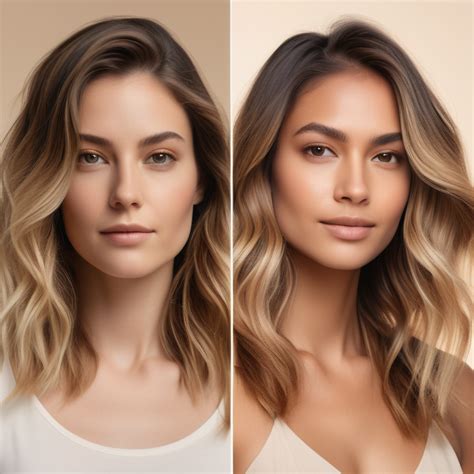Introduction:
Balayage and highlights are popular hair coloring techniques that can enhance your look. But what’s the difference between them? This article explores the key distinctions and guides you in choosing the best option for your unique style.

1. Application Method:
- Balayage: This freehand technique applies color by sweeping it onto the hair strands, creating a soft, gradient effect. It focuses on replicating the natural lightening seen in sun-kissed hair.
- Highlights: Highlights involve bleaching small sections of hair, typically using foils or a cap. This creates a more noticeable contrast and added volume.
2. Placement and Effect:
- Balayage: Balayage is applied throughout the hair, targeting specific areas to enhance movement and depth. It creates a subtle, dimensional look that blends seamlessly with your natural hair color.
- Highlights: Highlights are typically placed in precise sections, creating a more dramatic contrast and a brighter, more defined result. They can be customized to frame the face or add volume to certain areas.
3. Maintenance and Longevity:
- Balayage: Balayage tends to be lower maintenance than highlights as the regrowth is less noticeable. The color blends in gradually, eliminating the need for frequent touch-ups.
- Highlights: Highlights require more frequent touch-ups (every 4-6 weeks) to maintain their vibrancy. The bleached sections can become more visible as they grow out, creating a more noticeable transition.
4. Cost and Time:
- Balayage: Balayage is generally more expensive than highlights due to its time-consuming application process. It can take several hours to complete, depending on the length and thickness of your hair.
- Highlights: Highlights are typically more affordable than balayage. The application process is faster, leading to a shorter salon appointment.
5. Suitability:
- Balayage: Balayage is suitable for all hair types and colors, including fragile or damaged hair. It adds dimension without causing excessive damage.
- Highlights: Highlights are best suited for healthy hair that can withstand bleaching. They can be used to create more dramatic looks and add extra brightness.
Step-by-Step Approach:
-
Balayage:
- Section hair and apply a clarifying shampoo.
- Gently paint the color onto the hair strands using a sweeping motion.
- Allow the color to process and rinse thoroughly.
-
Highlights:
- Section hair and apply a protective cream around the hairline.
- Separate small sections and weave foils or wear a cap.
- Apply bleach to the highlighted sections and process according to the manufacturer’s instructions.
Tips and Tricks:
-
Balayage:
- Use a variety of brush sizes to create depth and dimension.
- Experiment with different colors to create custom looks.
-
Highlights:
- Use a toner to balance the color and eliminate unwanted brassiness.
- Add lowlights to create a more natural-looking effect.
Pros and Cons:
Balayage:
-
Pros:
- Creates a natural, sun-kissed look
- Less damaging than highlights
- Low maintenance
-
Cons:
- Can be more expensive
- Takes longer to apply
Highlights:
-
Pros:
- Creates a more dramatic, defined look
- Adds volume to hair
- More affordable
-
Cons:
- Can be more damaging to hair
- Requires frequent touch-ups
Conclusion:
Choosing between balayage and highlights depends on your desired look, hair condition, and budget. For a subtle, natural-looking enhancement, balayage is a great option. If you prefer a more defined, dramatic result, highlights may be better suited.
